FORD E-450 2004 Owners Manual
Manufacturer: FORD, Model Year: 2004, Model line: E-450, Model: FORD E-450 2004Pages: 240, PDF Size: 3.8 MB
Page 121 of 240
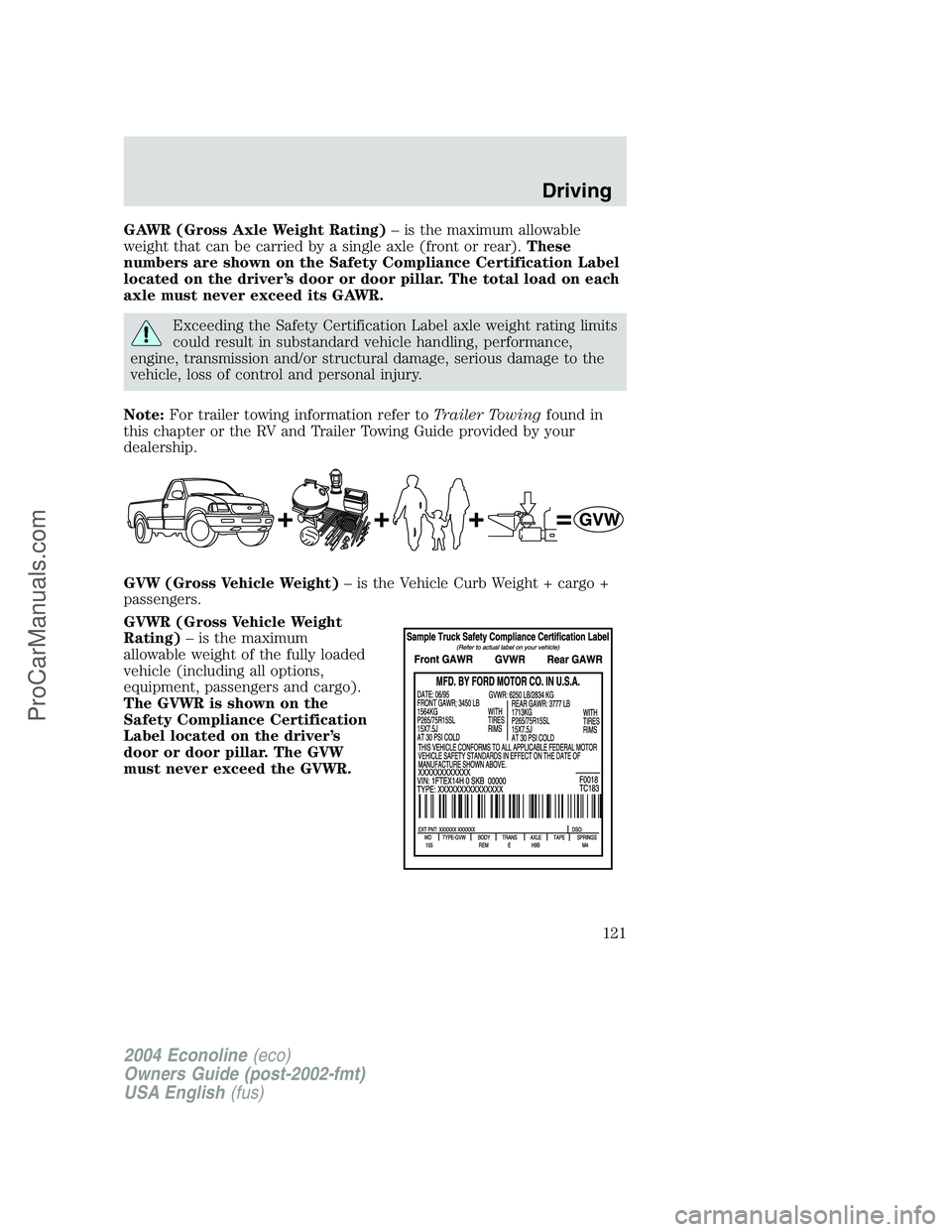
GAWR (Gross Axle Weight Rating)–is the maximum allowable
weight that can be carried by a single axle (front or rear).These
numbers are shown on the Safety Compliance Certification Label
located on the driver’s door or door pillar. The total load on each
axle must never exceed its GAWR.
Exceeding the Safety Certification Label axle weight rating limits
could result in substandard vehicle handling, performance,
engine, transmission and/or structural damage, serious damage to the
vehicle, loss of control and personal injury.
Note:For trailer towing information refer toTrailer Towingfound in
this chapter or the RV and Trailer Towing Guide provided by your
dealership.
GVW (Gross Vehicle Weight)–is the Vehicle Curb Weight + cargo +
passengers.
GVWR (Gross Vehicle Weight
Rating)–is the maximum
allowable weight of the fully loaded
vehicle (including all options,
equipment, passengers and cargo).
The GVWR is shown on the
Safety Compliance Certification
Label located on the driver’s
door or door pillar. The GVW
must never exceed the GVWR.
2004 Econoline(eco)
Owners Guide (post-2002-fmt)
USA English(fus)
Driving
121
ProCarManuals.com
Page 122 of 240
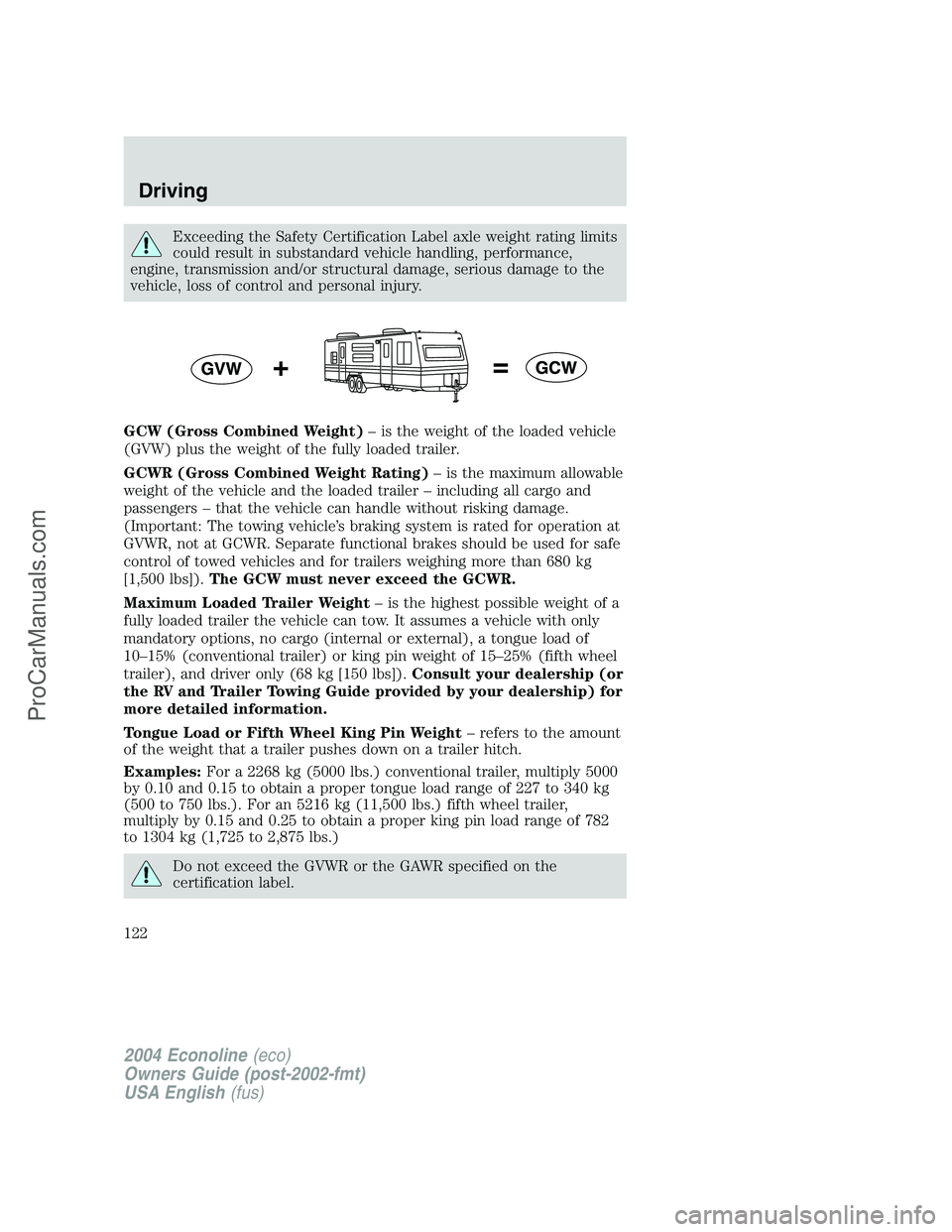
Exceeding the Safety Certification Label axle weight rating limits
could result in substandard vehicle handling, performance,
engine, transmission and/or structural damage, serious damage to the
vehicle, loss of control and personal injury.
GCW (Gross Combined Weight)–is the weight of the loaded vehicle
(GVW) plus the weight of the fully loaded trailer.
GCWR (Gross Combined Weight Rating)–is the maximum allowable
weight of the vehicle and the loaded trailer–including all cargo and
passengers–that the vehicle can handle without risking damage.
(Important: The towing vehicle’s braking system is rated for operation at
GVWR, not at GCWR. Separate functional brakes should be used for safe
control of towed vehicles and for trailers weighing more than 680 kg
[1,500 lbs]).The GCW must never exceed the GCWR.
Maximum Loaded Trailer Weight–is the highest possible weight of a
fully loaded trailer the vehicle can tow. It assumes a vehicle with only
mandatory options, no cargo (internal or external), a tongue load of
10–15% (conventional trailer) or king pin weight of 15–25% (fifth wheel
trailer), and driver only (68 kg [150 lbs]).Consult your dealership (or
the RV and Trailer Towing Guide provided by your dealership) for
more detailed information.
Tongue Load or Fifth Wheel King Pin Weight–refers to the amount
of the weight that a trailer pushes down on a trailer hitch.
Examples:For a 2268 kg (5000 lbs.) conventional trailer, multiply 5000
by 0.10 and 0.15 to obtain a proper tongue load range of 227 to 340 kg
(500 to 750 lbs.). For an 5216 kg (11,500 lbs.) fifth wheel trailer,
multiply by 0.15 and 0.25 to obtain a proper king pin load range of 782
to 1304 kg (1,725 to 2,875 lbs.)
Do not exceed the GVWR or the GAWR specified on the
certification label.
2004 Econoline(eco)
Owners Guide (post-2002-fmt)
USA English(fus)
Driving
122
ProCarManuals.com
Page 123 of 240
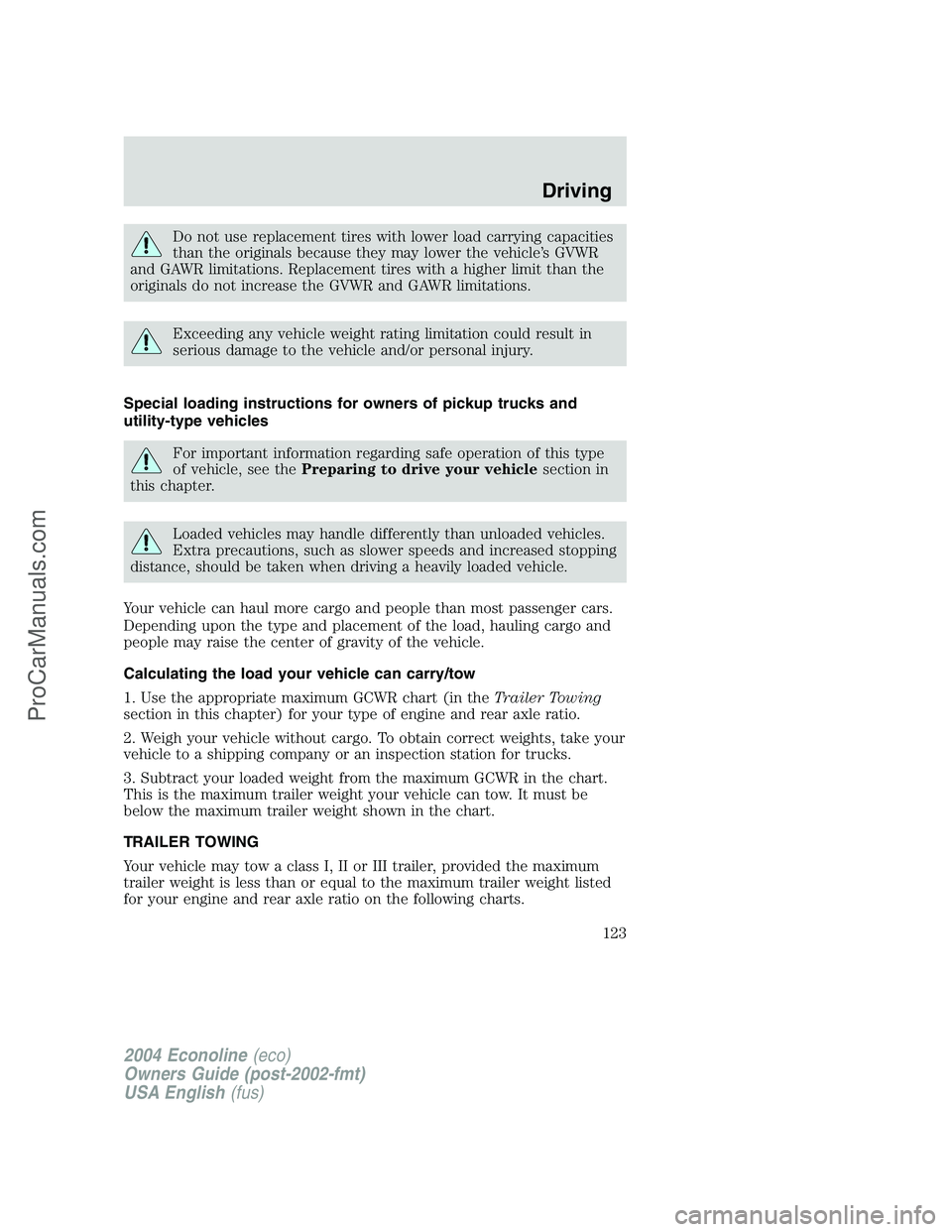
Do not use replacement tires with lower load carrying capacities
than the originals because they may lower the vehicle’s GVWR
and GAWR limitations. Replacement tires with a higher limit than the
originals do not increase the GVWR and GAWR limitations.
Exceeding any vehicle weight rating limitation could result in
serious damage to the vehicle and/or personal injury.
Special loading instructions for owners of pickup trucks and
utility-type vehicles
For important information regarding safe operation of this type
of vehicle, see thePreparing to drive your vehiclesection in
this chapter.
Loaded vehicles may handle differently than unloaded vehicles.
Extra precautions, such as slower speeds and increased stopping
distance, should be taken when driving a heavily loaded vehicle.
Your vehicle can haul more cargo and people than most passenger cars.
Depending upon the type and placement of the load, hauling cargo and
people may raise the center of gravity of the vehicle.
Calculating the load your vehicle can carry/tow
1. Use the appropriate maximum GCWR chart (in theTrailer Towing
section in this chapter) for your type of engine and rear axle ratio.
2. Weigh your vehicle without cargo. To obtain correct weights, take your
vehicle to a shipping company or an inspection station for trucks.
3. Subtract your loaded weight from the maximum GCWR in the chart.
This is the maximum trailer weight your vehicle can tow. It must be
below the maximum trailer weight shown in the chart.
TRAILER TOWING
Your vehicle may tow a class I, II or III trailer, provided the maximum
trailer weight is less than or equal to the maximum trailer weight listed
for your engine and rear axle ratio on the following charts.
2004 Econoline(eco)
Owners Guide (post-2002-fmt)
USA English(fus)
Driving
123
ProCarManuals.com
Page 124 of 240
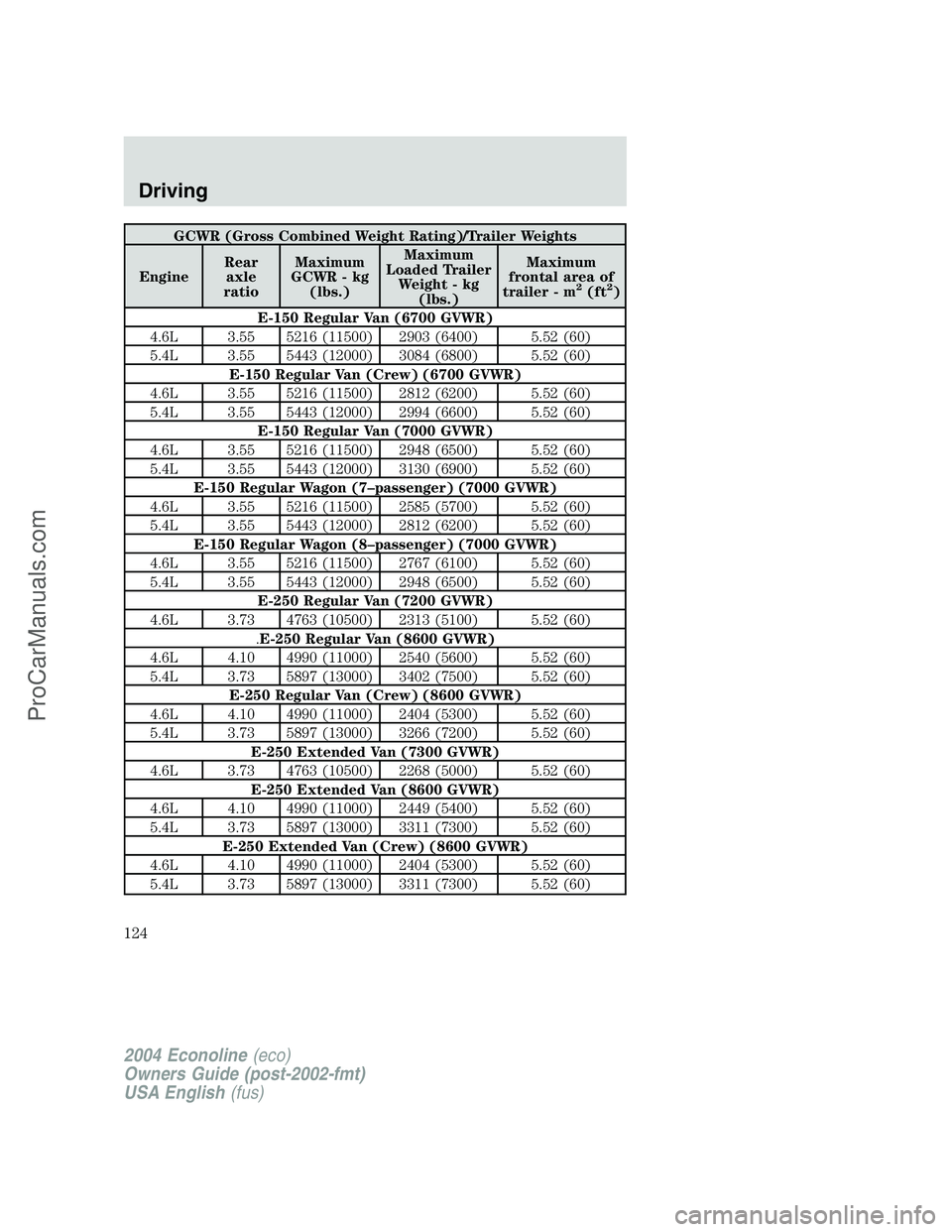
GCWR (Gross Combined Weight Rating)/Trailer Weights
EngineRear
axle
ratioMaximum
GCWR - kg
(lbs.)Maximum
Loaded Trailer
Weight - kg
(lbs.)Maximum
frontal area of
trailer - m
2(ft2)
E-150 Regular Van (6700 GVWR)
4.6L 3.55 5216 (11500) 2903 (6400) 5.52 (60)
5.4L 3.55 5443 (12000) 3084 (6800) 5.52 (60)
E-150 Regular Van (Crew) (6700 GVWR)
4.6L 3.55 5216 (11500) 2812 (6200) 5.52 (60)
5.4L 3.55 5443 (12000) 2994 (6600) 5.52 (60)
E-150 Regular Van (7000 GVWR)
4.6L 3.55 5216 (11500) 2948 (6500) 5.52 (60)
5.4L 3.55 5443 (12000) 3130 (6900) 5.52 (60)
E-150 Regular Wagon (7–passenger) (7000 GVWR)
4.6L 3.55 5216 (11500) 2585 (5700) 5.52 (60)
5.4L 3.55 5443 (12000) 2812 (6200) 5.52 (60)
E-150 Regular Wagon (8–passenger) (7000 GVWR)
4.6L 3.55 5216 (11500) 2767 (6100) 5.52 (60)
5.4L 3.55 5443 (12000) 2948 (6500) 5.52 (60)
E-250 Regular Van (7200 GVWR)
4.6L 3.73 4763 (10500) 2313 (5100) 5.52 (60)
.E-250 Regular Van (8600 GVWR)
4.6L 4.10 4990 (11000) 2540 (5600) 5.52 (60)
5.4L 3.73 5897 (13000) 3402 (7500) 5.52 (60)
E-250 Regular Van (Crew) (8600 GVWR)
4.6L 4.10 4990 (11000) 2404 (5300) 5.52 (60)
5.4L 3.73 5897 (13000) 3266 (7200) 5.52 (60)
E-250 Extended Van (7300 GVWR)
4.6L 3.73 4763 (10500) 2268 (5000) 5.52 (60)
E-250 Extended Van (8600 GVWR)
4.6L 4.10 4990 (11000) 2449 (5400) 5.52 (60)
5.4L 3.73 5897 (13000) 3311 (7300) 5.52 (60)
E-250 Extended Van (Crew) (8600 GVWR)
4.6L 4.10 4990 (11000) 2404 (5300) 5.52 (60)
5.4L 3.73 5897 (13000) 3311 (7300) 5.52 (60)
2004 Econoline(eco)
Owners Guide (post-2002-fmt)
USA English(fus)
Driving
124
ProCarManuals.com
Page 125 of 240
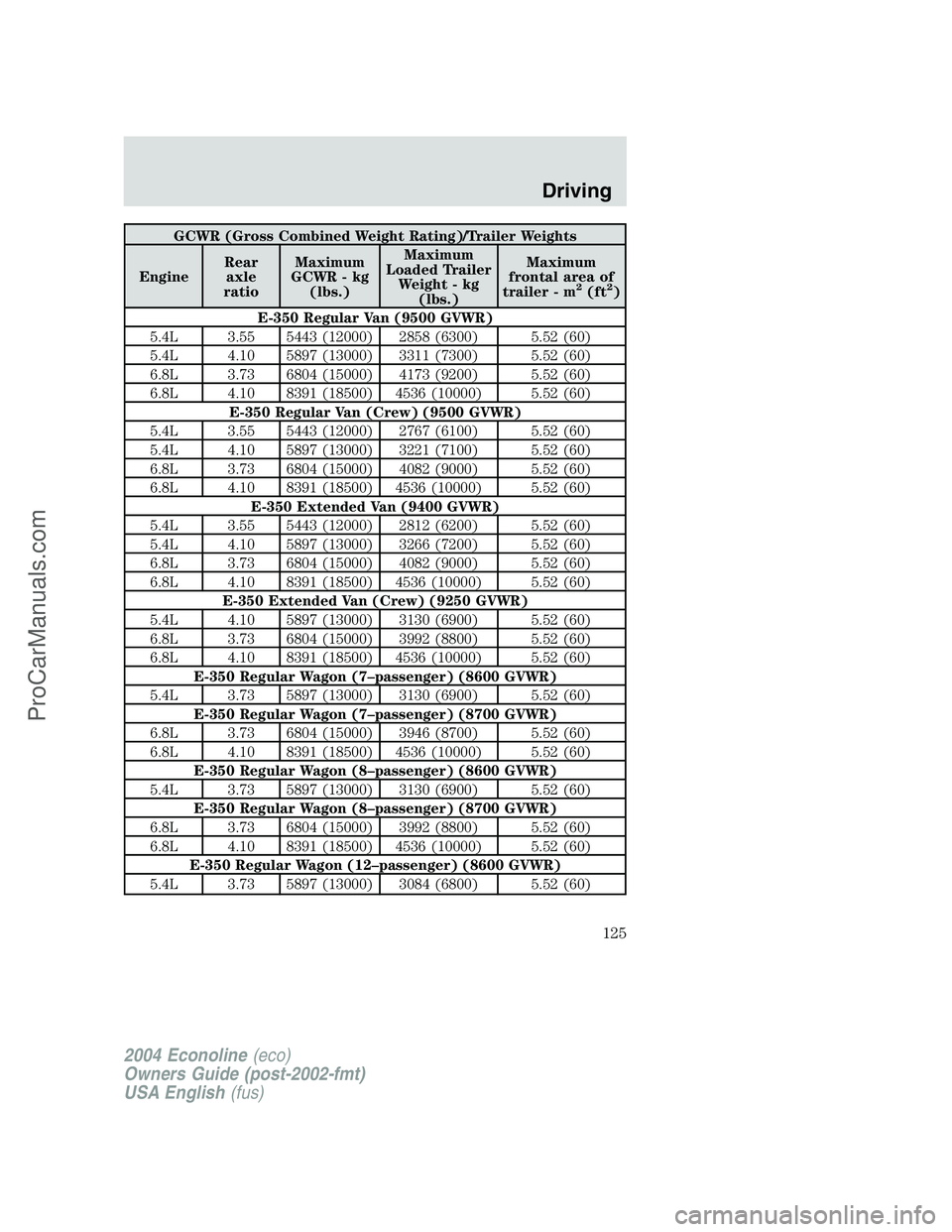
GCWR (Gross Combined Weight Rating)/Trailer Weights
EngineRear
axle
ratioMaximum
GCWR - kg
(lbs.)Maximum
Loaded Trailer
Weight - kg
(lbs.)Maximum
frontal area of
trailer - m
2(ft2)
E-350 Regular Van (9500 GVWR)
5.4L 3.55 5443 (12000) 2858 (6300) 5.52 (60)
5.4L 4.10 5897 (13000) 3311 (7300) 5.52 (60)
6.8L 3.73 6804 (15000) 4173 (9200) 5.52 (60)
6.8L 4.10 8391 (18500) 4536 (10000) 5.52 (60)
E-350 Regular Van (Crew) (9500 GVWR)
5.4L 3.55 5443 (12000) 2767 (6100) 5.52 (60)
5.4L 4.10 5897 (13000) 3221 (7100) 5.52 (60)
6.8L 3.73 6804 (15000) 4082 (9000) 5.52 (60)
6.8L 4.10 8391 (18500) 4536 (10000) 5.52 (60)
E-350 Extended Van (9400 GVWR)
5.4L 3.55 5443 (12000) 2812 (6200) 5.52 (60)
5.4L 4.10 5897 (13000) 3266 (7200) 5.52 (60)
6.8L 3.73 6804 (15000) 4082 (9000) 5.52 (60)
6.8L 4.10 8391 (18500) 4536 (10000) 5.52 (60)
E-350 Extended Van (Crew) (9250 GVWR)
5.4L 4.10 5897 (13000) 3130 (6900) 5.52 (60)
6.8L 3.73 6804 (15000) 3992 (8800) 5.52 (60)
6.8L 4.10 8391 (18500) 4536 (10000) 5.52 (60)
E-350 Regular Wagon (7–passenger) (8600 GVWR)
5.4L 3.73 5897 (13000) 3130 (6900) 5.52 (60)
E-350 Regular Wagon (7–passenger) (8700 GVWR)
6.8L 3.73 6804 (15000) 3946 (8700) 5.52 (60)
6.8L 4.10 8391 (18500) 4536 (10000) 5.52 (60)
E-350 Regular Wagon (8–passenger) (8600 GVWR)
5.4L 3.73 5897 (13000) 3130 (6900) 5.52 (60)
E-350 Regular Wagon (8–passenger) (8700 GVWR)
6.8L 3.73 6804 (15000) 3992 (8800) 5.52 (60)
6.8L 4.10 8391 (18500) 4536 (10000) 5.52 (60)
E-350 Regular Wagon (12–passenger) (8600 GVWR)
5.4L 3.73 5897 (13000) 3084 (6800) 5.52 (60)
2004 Econoline(eco)
Owners Guide (post-2002-fmt)
USA English(fus)
Driving
125
ProCarManuals.com
Page 126 of 240
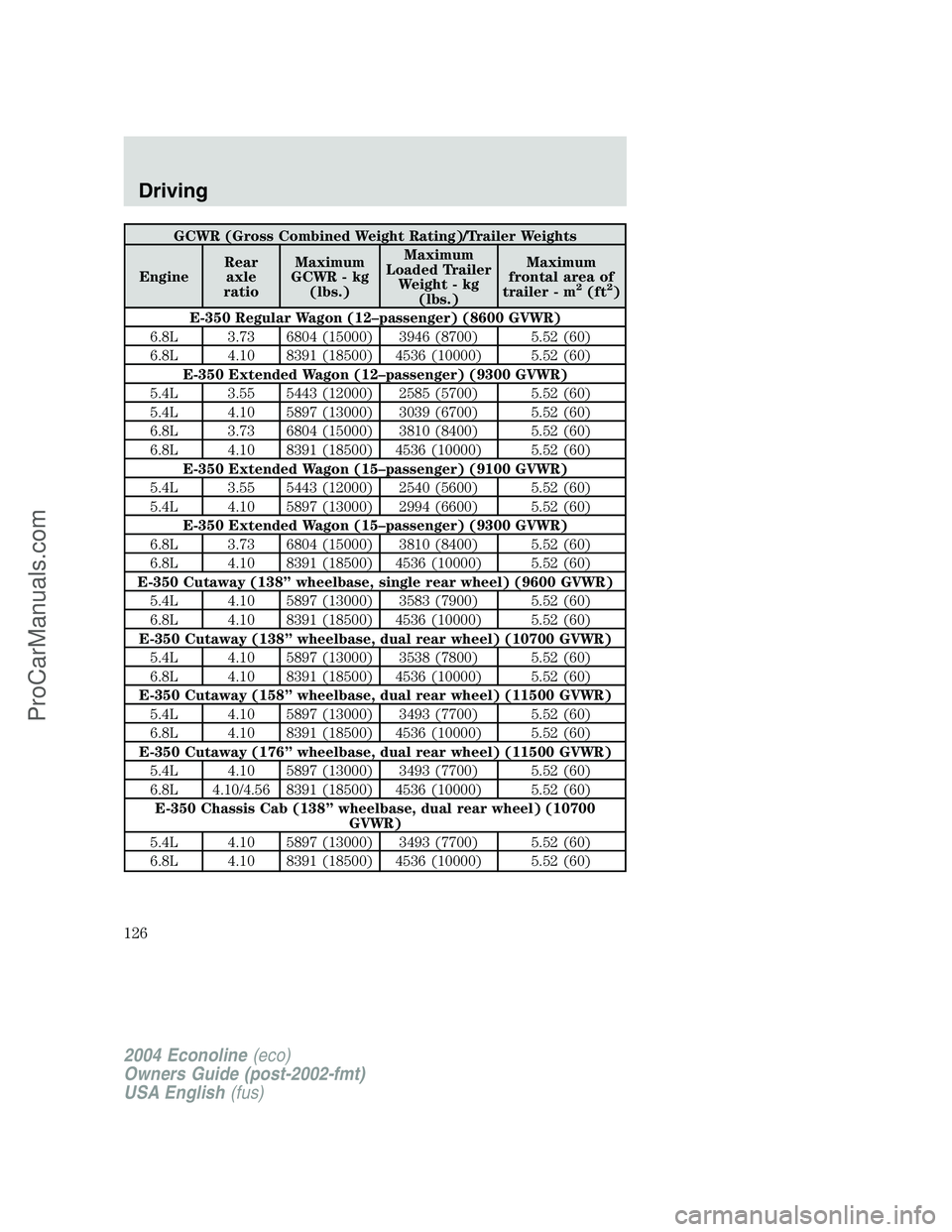
GCWR (Gross Combined Weight Rating)/Trailer Weights
EngineRear
axle
ratioMaximum
GCWR - kg
(lbs.)Maximum
Loaded Trailer
Weight - kg
(lbs.)Maximum
frontal area of
trailer - m
2(ft2)
E-350 Regular Wagon (12–passenger) (8600 GVWR)
6.8L 3.73 6804 (15000) 3946 (8700) 5.52 (60)
6.8L 4.10 8391 (18500) 4536 (10000) 5.52 (60)
E-350 Extended Wagon (12–passenger) (9300 GVWR)
5.4L 3.55 5443 (12000) 2585 (5700) 5.52 (60)
5.4L 4.10 5897 (13000) 3039 (6700) 5.52 (60)
6.8L 3.73 6804 (15000) 3810 (8400) 5.52 (60)
6.8L 4.10 8391 (18500) 4536 (10000) 5.52 (60)
E-350 Extended Wagon (15–passenger) (9100 GVWR)
5.4L 3.55 5443 (12000) 2540 (5600) 5.52 (60)
5.4L 4.10 5897 (13000) 2994 (6600) 5.52 (60)
E-350 Extended Wagon (15–passenger) (9300 GVWR)
6.8L 3.73 6804 (15000) 3810 (8400) 5.52 (60)
6.8L 4.10 8391 (18500) 4536 (10000) 5.52 (60)
E-350 Cutaway (138”wheelbase, single rear wheel) (9600 GVWR)
5.4L 4.10 5897 (13000) 3583 (7900) 5.52 (60)
6.8L 4.10 8391 (18500) 4536 (10000) 5.52 (60)
E-350 Cutaway (138”wheelbase, dual rear wheel) (10700 GVWR)
5.4L 4.10 5897 (13000) 3538 (7800) 5.52 (60)
6.8L 4.10 8391 (18500) 4536 (10000) 5.52 (60)
E-350 Cutaway (158”wheelbase, dual rear wheel) (11500 GVWR)
5.4L 4.10 5897 (13000) 3493 (7700) 5.52 (60)
6.8L 4.10 8391 (18500) 4536 (10000) 5.52 (60)
E-350 Cutaway (176”wheelbase, dual rear wheel) (11500 GVWR)
5.4L 4.10 5897 (13000) 3493 (7700) 5.52 (60)
6.8L 4.10/4.56 8391 (18500) 4536 (10000) 5.52 (60)
E-350 Chassis Cab (138”wheelbase, dual rear wheel) (10700
GVWR)
5.4L 4.10 5897 (13000) 3493 (7700) 5.52 (60)
6.8L 4.10 8391 (18500) 4536 (10000) 5.52 (60)
2004 Econoline(eco)
Owners Guide (post-2002-fmt)
USA English(fus)
Driving
126
ProCarManuals.com
Page 127 of 240
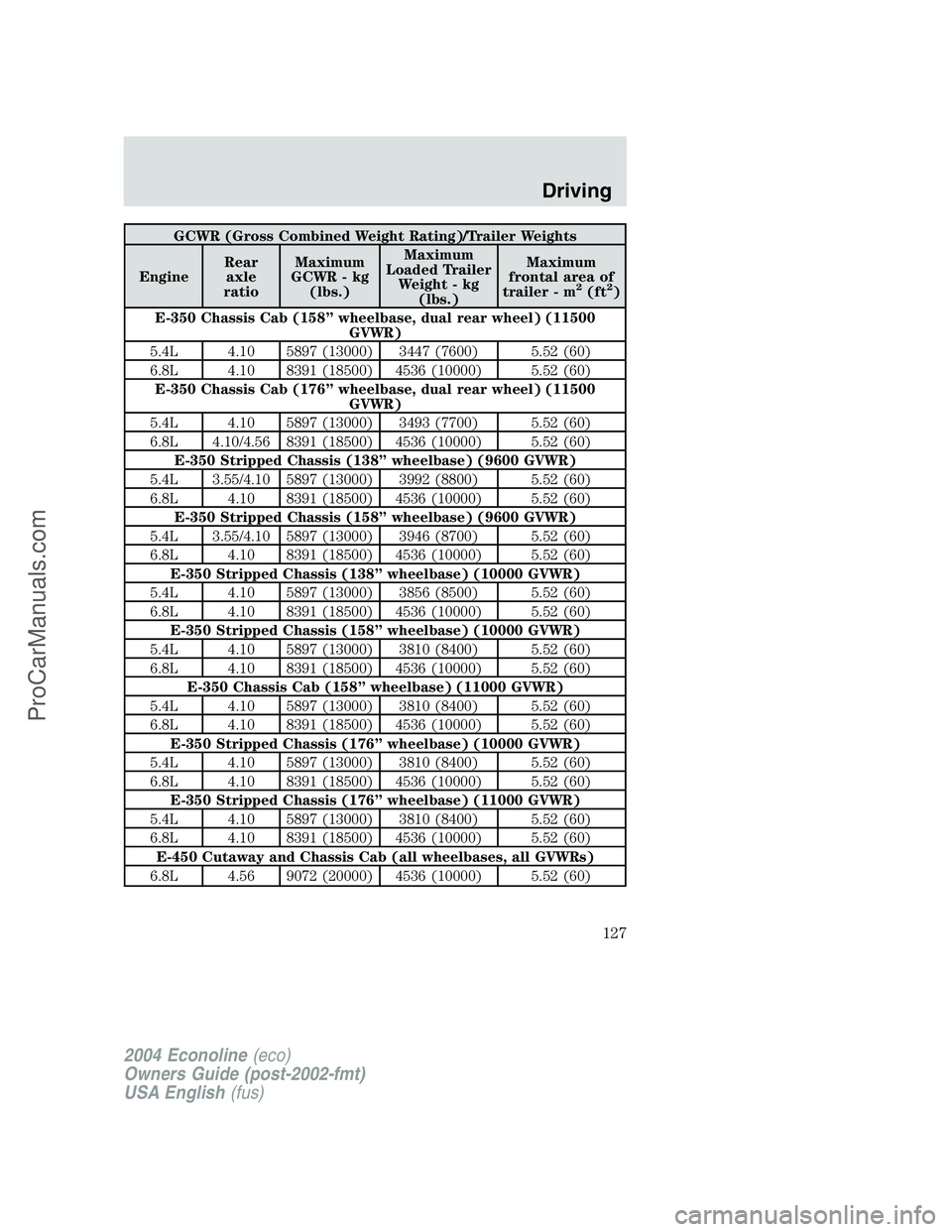
GCWR (Gross Combined Weight Rating)/Trailer Weights
EngineRear
axle
ratioMaximum
GCWR - kg
(lbs.)Maximum
Loaded Trailer
Weight - kg
(lbs.)Maximum
frontal area of
trailer - m
2(ft2)
E-350 Chassis Cab (158”wheelbase, dual rear wheel) (11500
GVWR)
5.4L 4.10 5897 (13000) 3447 (7600) 5.52 (60)
6.8L 4.10 8391 (18500) 4536 (10000) 5.52 (60)
E-350 Chassis Cab (176”wheelbase, dual rear wheel) (11500
GVWR)
5.4L 4.10 5897 (13000) 3493 (7700) 5.52 (60)
6.8L 4.10/4.56 8391 (18500) 4536 (10000) 5.52 (60)
E-350 Stripped Chassis (138”wheelbase) (9600 GVWR)
5.4L 3.55/4.10 5897 (13000) 3992 (8800) 5.52 (60)
6.8L 4.10 8391 (18500) 4536 (10000) 5.52 (60)
E-350 Stripped Chassis (158”wheelbase) (9600 GVWR)
5.4L 3.55/4.10 5897 (13000) 3946 (8700) 5.52 (60)
6.8L 4.10 8391 (18500) 4536 (10000) 5.52 (60)
E-350 Stripped Chassis (138”wheelbase) (10000 GVWR)
5.4L 4.10 5897 (13000) 3856 (8500) 5.52 (60)
6.8L 4.10 8391 (18500) 4536 (10000) 5.52 (60)
E-350 Stripped Chassis (158”wheelbase) (10000 GVWR)
5.4L 4.10 5897 (13000) 3810 (8400) 5.52 (60)
6.8L 4.10 8391 (18500) 4536 (10000) 5.52 (60)
E-350 Chassis Cab (158”wheelbase) (11000 GVWR)
5.4L 4.10 5897 (13000) 3810 (8400) 5.52 (60)
6.8L 4.10 8391 (18500) 4536 (10000) 5.52 (60)
E-350 Stripped Chassis (176”wheelbase) (10000 GVWR)
5.4L 4.10 5897 (13000) 3810 (8400) 5.52 (60)
6.8L 4.10 8391 (18500) 4536 (10000) 5.52 (60)
E-350 Stripped Chassis (176”wheelbase) (11000 GVWR)
5.4L 4.10 5897 (13000) 3810 (8400) 5.52 (60)
6.8L 4.10 8391 (18500) 4536 (10000) 5.52 (60)
E-450 Cutaway and Chassis Cab (all wheelbases, all GVWRs)
6.8L 4.56 9072 (20000) 4536 (10000) 5.52 (60)
2004 Econoline(eco)
Owners Guide (post-2002-fmt)
USA English(fus)
Driving
127
ProCarManuals.com
Page 128 of 240
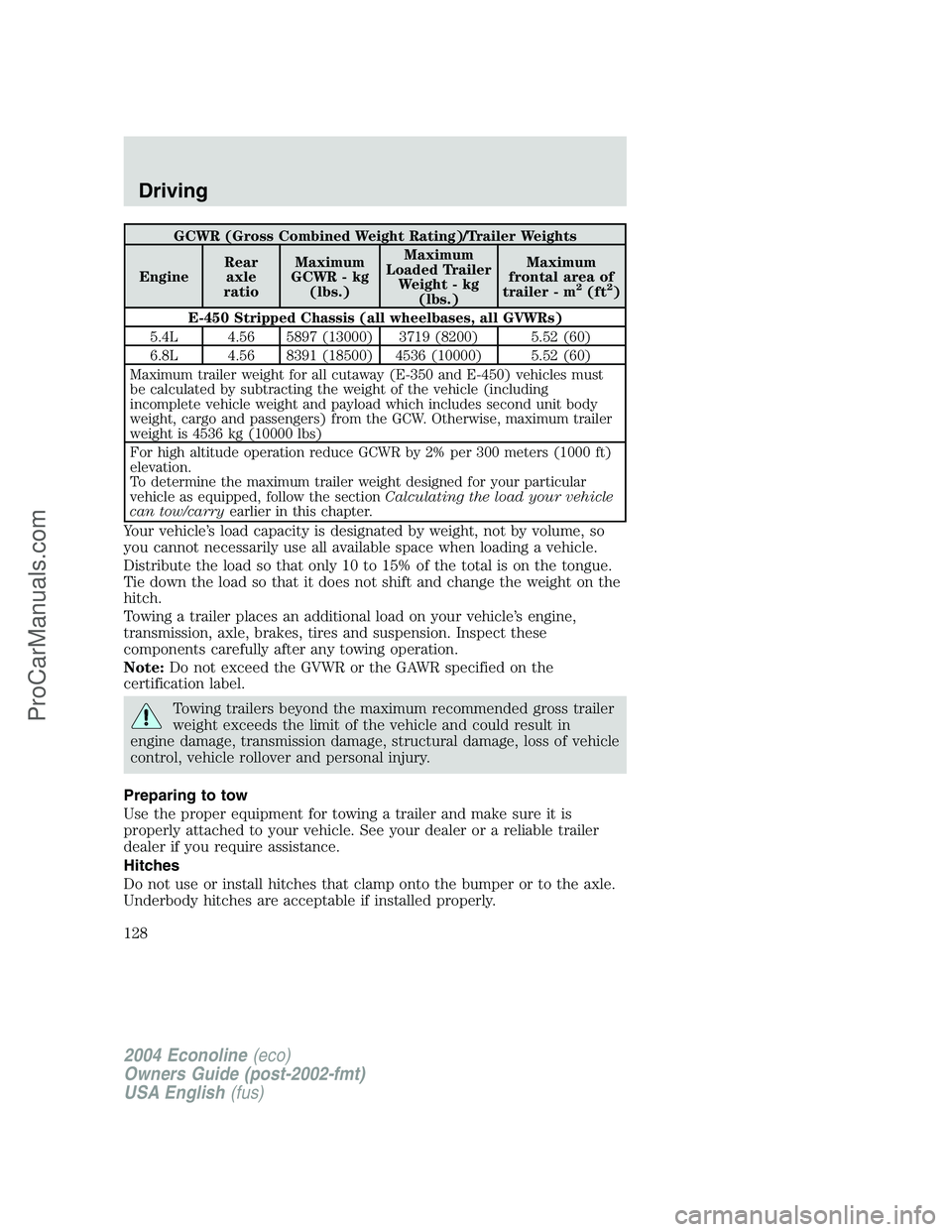
GCWR (Gross Combined Weight Rating)/Trailer Weights
EngineRear
axle
ratioMaximum
GCWR - kg
(lbs.)Maximum
Loaded Trailer
Weight - kg
(lbs.)Maximum
frontal area of
trailer - m
2(ft2)
E-450 Stripped Chassis (all wheelbases, all GVWRs)
5.4L 4.56 5897 (13000) 3719 (8200) 5.52 (60)
6.8L 4.56 8391 (18500) 4536 (10000) 5.52 (60)
Maximum trailer weight for all cutaway (E-350 and E-450) vehicles must
be calculated by subtracting the weight of the vehicle (including
incomplete vehicle weight and payload which includes second unit body
weight, cargo and passengers) from the GCW. Otherwise, maximum trailer
weight is 4536 kg (10000 lbs)
For high altitude operation reduce GCWR by 2% per 300 meters (1000 ft)
elevation.
To determine the maximum trailer weight designed for your particular
vehicle as equipped, follow the sectionCalculating the load your vehicle
can tow/carryearlier in this chapter.
Your vehicle’s load capacity is designated by weight, not by volume, so
you cannot necessarily use all available space when loading a vehicle.
Distribute the load so that only 10 to 15% of the total is on the tongue.
Tie down the load so that it does not shift and change the weight on the
hitch.
Towing a trailer places an additional load on your vehicle’s engine,
transmission, axle, brakes, tires and suspension. Inspect these
components carefully after any towing operation.
Note:Do not exceed the GVWR or the GAWR specified on the
certification label.
Towing trailers beyond the maximum recommended gross trailer
weight exceeds the limit of the vehicle and could result in
engine damage, transmission damage, structural damage, loss of vehicle
control, vehicle rollover and personal injury.
Preparing to tow
Use the proper equipment for towing a trailer and make sure it is
properly attached to your vehicle. See your dealer or a reliable trailer
dealer if you require assistance.
Hitches
Do not use or install hitches that clamp onto the bumper or to the axle.
Underbody hitches are acceptable if installed properly.
2004 Econoline(eco)
Owners Guide (post-2002-fmt)
USA English(fus)
Driving
128
ProCarManuals.com
Page 129 of 240
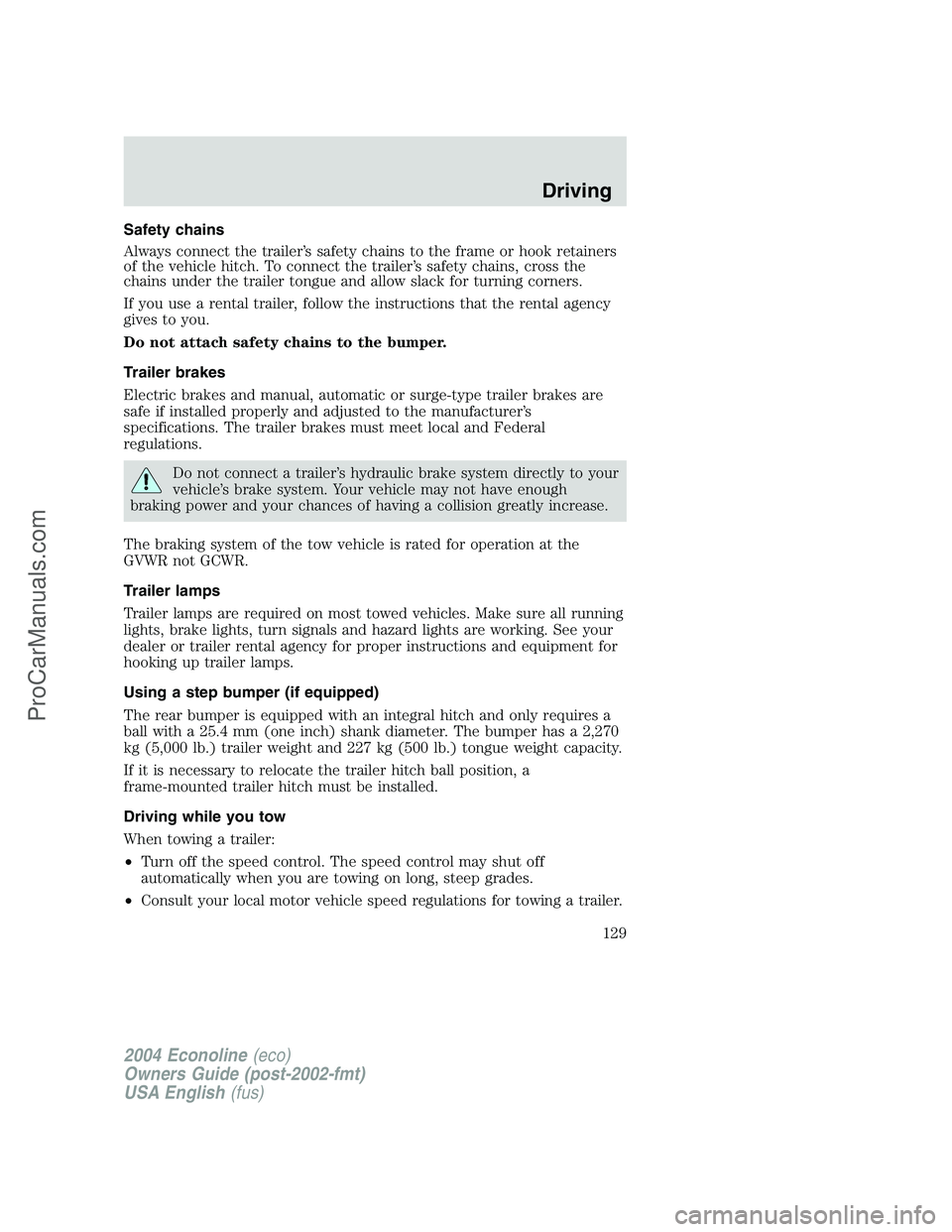
Safety chains
Always connect the trailer’s safety chains to the frame or hook retainers
of the vehicle hitch. To connect the trailer’s safety chains, cross the
chains under the trailer tongue and allow slack for turning corners.
If you use a rental trailer, follow the instructions that the rental agency
gives to you.
Do not attach safety chains to the bumper.
Trailer brakes
Electric brakes and manual, automatic or surge-type trailer brakes are
safe if installed properly and adjusted to the manufacturer’s
specifications. The trailer brakes must meet local and Federal
regulations.
Do not connect a trailer’s hydraulic brake system directly to your
vehicle’s brake system. Your vehicle may not have enough
braking power and your chances of having a collision greatly increase.
The braking system of the tow vehicle is rated for operation at the
GVWR not GCWR.
Trailer lamps
Trailer lamps are required on most towed vehicles. Make sure all running
lights, brake lights, turn signals and hazard lights are working. See your
dealer or trailer rental agency for proper instructions and equipment for
hooking up trailer lamps.
Using a step bumper (if equipped)
The rear bumper is equipped with an integral hitch and only requires a
ball with a 25.4 mm (one inch) shank diameter. The bumper has a 2,270
kg (5,000 lb.) trailer weight and 227 kg (500 lb.) tongue weight capacity.
If it is necessary to relocate the trailer hitch ball position, a
frame-mounted trailer hitch must be installed.
Driving while you tow
When towing a trailer:
•Turn off the speed control. The speed control may shut off
automatically when you are towing on long, steep grades.
•Consult your local motor vehicle speed regulations for towing a trailer.
2004 Econoline(eco)
Owners Guide (post-2002-fmt)
USA English(fus)
Driving
129
ProCarManuals.com
Page 130 of 240
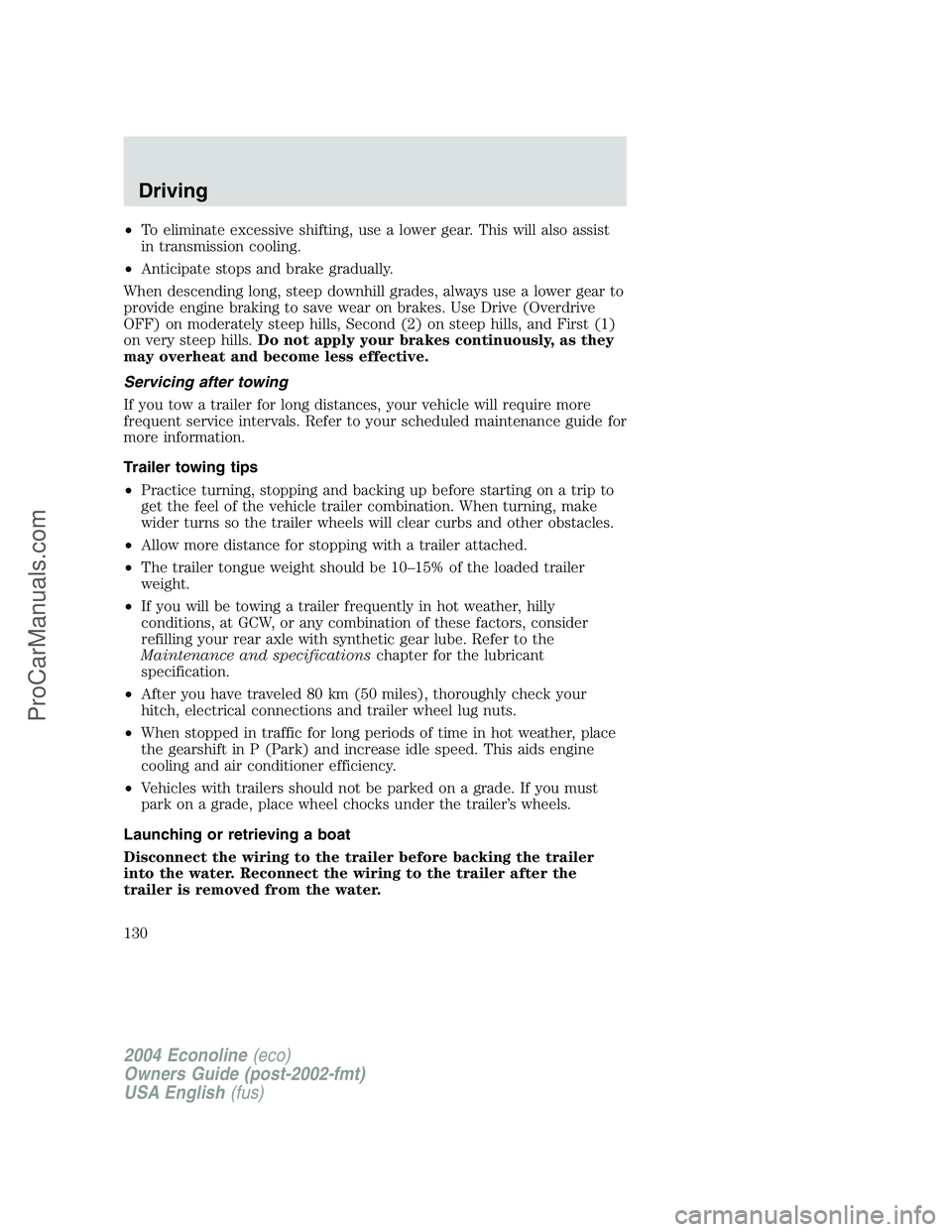
•To eliminate excessive shifting, use a lower gear. This will also assist
in transmission cooling.
•Anticipate stops and brake gradually.
When descending long, steep downhill grades, always use a lower gear to
provide engine braking to save wear on brakes. Use Drive (Overdrive
OFF) on moderately steep hills, Second (2) on steep hills, and First (1)
on very steep hills.Do not apply your brakes continuously, as they
may overheat and become less effective.
Servicing after towing
If you tow a trailer for long distances, your vehicle will require more
frequent service intervals. Refer to your scheduled maintenance guide for
more information.
Trailer towing tips
•Practice turning, stopping and backing up before starting on a trip to
get the feel of the vehicle trailer combination. When turning, make
wider turns so the trailer wheels will clear curbs and other obstacles.
•Allow more distance for stopping with a trailer attached.
•The trailer tongue weight should be 10–15% of the loaded trailer
weight.
•If you will be towing a trailer frequently in hot weather, hilly
conditions, at GCW, or any combination of these factors, consider
refilling your rear axle with synthetic gear lube. Refer to the
Maintenance and specificationschapter for the lubricant
specification.
•After you have traveled 80 km (50 miles), thoroughly check your
hitch, electrical connections and trailer wheel lug nuts.
•When stopped in traffic for long periods of time in hot weather, place
the gearshift in P (Park) and increase idle speed. This aids engine
cooling and air conditioner efficiency.
•Vehicles with trailers should not be parked on a grade. If you must
park on a grade, place wheel chocks under the trailer’s wheels.
Launching or retrieving a boat
Disconnect the wiring to the trailer before backing the trailer
into the water. Reconnect the wiring to the trailer after the
trailer is removed from the water.
2004 Econoline(eco)
Owners Guide (post-2002-fmt)
USA English(fus)
Driving
130
ProCarManuals.com